When you walk into a brewery and sit down for a pour, the first thing you do is scan the menu looking, often, for something you are familiar with to drink. Beer is defined by its style. A Lager should be light and crushable. IPAs will be hop-forward, but depending on the coast, it will be bitter and dank (West Coast) or a juice bomb (East Coast). But what does it mean when you see American Wild Ale, Flanders Red Ale, Lambic, Gose, Kettle sour, or even Berliner Weisse?
When you see these styles, you have moved into the sour beer category. Without a doubt, when you sip on anything sour you are going to get notes of tartness that sometimes cross over into pucker inducing. There will be funk(iness) and yes that is a good thing. Some sour beers will be fruited, and some beers will stand alone. It’s not about creating sour for sour’s sake but balanced beers that showcase the yeast. The yeast is what gives the beer the sour character.
In Belgium, sour beers have been brewed for over 100 years at places such as Cantillon and Brouwerji 3 Fonteinen. For a beer to be a true Lambic or Gueuze, it must come from this area of the world and this area alone. The yeast used for these beers comes from the air spontaneously. After a beer is brewed, it is placed in a large Koelschip (often a long, metal, open-top flat vessel) in a room with the windows open. The goal is for naturally occurring bacteria in the air to land in the beer and begin to eat the sugars from the wort, thus giving the beer its signature funk.
The beers of Casey Brewing and Blending are also defined by their yeast, a mixed culture. This mixed culture is a combination of Saccharomyces, Brettanomyces, and lactic acid bacteria. This doesn’t mean that every Casey Brewing sour beer will give you the same tasting experience, you can put the same beer into two different barrels and garner very different results, that’s the beauty and risk of sour beer.
“The uncertainty of the flavors that are possible is what keeps me excited about these styles. You never know what flavors might come out. All you can do is wait and see. That’s where blending comes into play, and we really get to have fun.”
Troy Casey
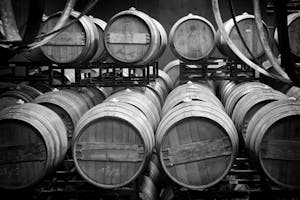
The Oldest Beer in History?
This style of beer is not new. In fact, the existence of beer has been traced back as far as around 4000 – 5000 BC, and up until just a couple of hundred years ago, almost all beers were “sour.” Most modern brewing methods keep out unwanted bacteria by using sterilized air and equipment with closed containers. However, go back in time, and you would find open containers being used for fermentation. This allowed wild bacteria and yeast in the air to make their way into the brew, contributing to the zingy flavor profile. Another factor was that just as you use a “starter” to make sourdough bread, in traditional brewing, a “starter” would be used in the next batch, so the bacteria that had been picked up along the way would be transferred into the new batch as well.
Things started to change in the 1800s when mechanical refrigeration was invented and scientist Louis Pasteur invented the process we know as pasteurization, which meant liquids would be heated to a high temperature that would kill the bacteria already present, with the purpose of preserving the product. The increasing use of these methods resulted in the production of more lager and ale, which became popular and gradually replaced sour beers.
The return to this ancient brewing style can be attributed to the Belgium breweries that have consistently used these methods for the last 100 years, inspiring many brewers worldwide to explore this ancient craft, including ourselves at Casey Brewing.
Fruit and Sour Beer
The concept of adding fruit to beer is again not new. It dates almost as far back as the history of beer itself – the earliest record of fruited beer being from China in 7000 BC – and throughout history, brewers all over the world have experimented with fruited beers. However, the real tradition of modern fruited beers started in the 1930s in Belgium, where the first cherry lambics and krieks were created.
Over the years, here at Casey Brewing, we have brewed sour beers with the following fruits; apricot, blackberry, cherry, grape, peach, nectarine, plum, pluot, marionberry, aprium, currant, raspberry, and for the first time this year, pear!
We don’t just use one variety of each type of fruit either, as each variety has its own flavor within the category. Take cherries, for example, some varieties we have used include Balaton, Montmorency, Bing, Attika, Lapin, Danube, and that’s not all! Each type of cherry has a different taste – for example, Bing cherries are sweet. In contrast, Montmorency and Balaton are sour varieties, so of course, when blended with a beer, each variety uniquely enhances the beer, and the end result is that each batch has a distinct flavor and color.

Grapes are another category within which we have used many varieties, including dark grapes such as Merlot, Cabernet Sauvignon, Cabernet Franc, and white varieties such as Chardonnay, Riesling, Viognier – to name a few. You’re probably thinking of wines now, and here we see a parallel. Be it Merlot, or Chardonnay, we know these wines all have different tastes, and for this reason, we often consider first what we are eating to decide which wine will complement our meal. So too with our beers, when we add these different grape varieties to our blends, we get different results with varying flavor profiles.
Each brewer may add fruit at a different time during the process, depending on the style or flavor profile they hope to produce. At Casey, we only add the fruit after the fermentation process; once the beer has been aged in barrels for months, even years, and is tasting just how we want it, the beer is then added to the fruit and left to age for a further four weeks or so before bottling.
We never add fruit in the hope of correcting a batch that is not quite right. The fruit is added to enhance the very flavor we wish to create and is carefully chosen to compliment the beer. How so?
Put simply, it’s all about balance. Each batch of fruit and each barrel of beer will vary in acidity. Therefore, barrels will be carefully chosen to pair with the fruit. A less acidic barrel may be matched with more acidic fruit and vice versa. The amount of fruit added is also thoughtfully considered by our brewmaster Troy Casey with the team and will depend on the exact intensity of flavor we desire.
Sour Beer and Hops
Hops are one of the basic ingredients of any beer and are used by brewers for different purposes. They can be used to impart a different flavor and aroma – to add fruity, citrus, or floral notes, for instance – or to add bitterness. They are also used for their antimicrobial properties to control bacteria levels. Adding hops at the boiling stage can harness this antimicrobial effect, as at this temperature, the acids in the hops will become bacteriostatic, which means that without killing the bacteria present, they will stop the bacteria from multiplying anymore.
The flavors and degree of bitterness that comes from hops will depend on what stage in the brewing process the hops are added and whether or not the hops have been aged. With age, the hops oxidize, and this causes the acids within to change. The result of using aged hops in brewing is that the bitterness is reduced. For this reason, Belgian brewers traditionally use aged hops for Lambic-style beers.
At Casey Brewing, we use both pelletized hops and “wet hops” – hops that are still fresh, right off the hop bine and full of moisture – depending on the flavor profile we want to create.
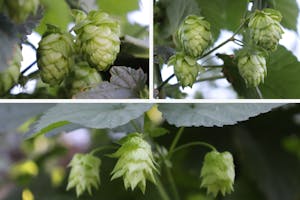
Dry-hopping is a centuries-old technique of adding hops after the boiling stage, bringing an extra infusion of fresh aroma and flavor. We dry-hop some of our “base beers” to create unique blends. We did this with one barrel of our sour ale Oak Theory and added hops right before bottling to add citrus and juicy notes to the base beer, which created a new distinctive sour ale Dry Hopped Oak Theory.
How We Create Sour Beer at Casey Brewing
At Casey Brewing, all our sour beer is fermented using old-world techniques. There are a few steps before the fermentation can begin. First, malted grain is crushed with a mill. After that comes the mashing process where the crushed malt is mixed in with incredibly hot water. The goal of this mashing process is to enable certain enzymes to become active which causes them to convert starches in the malt into fermentable sugars. The water is then separated from the spent grain and sent to the boil kettle. At this point, the water is referred to as wort and is set to boil. Now the hops come into play, depending on this timing, it will create a more or less bitter version of the beer. Once the boil is completed, it’s on to fermentation; the wort is cooled in custom, open-top oak fermenters with our proprietary mixed culture containing Saison yeast, Brettanomyces, and lactic acid bugs. The yeast will then consume the sugars, which creates the alcohol.

After fermentation, the beer is racked into neutral vintage oak wine barrels for months, sometimes years, of aging. This aging process allows for micro-oxidation through the barrel’s oak, slowly feeding the yeast culture to coax the flavors and acid we’re looking for.
Granted, this process takes time, and more modern methods may produce a quicker result, but from our perspective, this is a labor of love, and it’s worth the wait.
Ancient vs Modern Methods of Souring
The methods we use today are heavily inspired by traditional processes and can be differentiated by the way bacteria is introduced during the fermentation process.
Spontaneous Fermentation
The traditional Belgian method mentioned earlier, known as spontaneous fermentation, involves the use of a “coolship” (koelschip), so that wild yeast and bacteria in the air can make their way into the wort. While this method isn’t used in all Belgian brews, it is a requisite for styles such as Lambic and Gueuze.
Lambic Beers
Lambic beer is, in our opinion, one of the most fascinating styles of beer. Lambics are made using spontaneous fermentation, and a lambic is never blended. It is made from a single barrel, whereas other Belgian styles are made using a blend of barrels; gueuze, for example, is made from a blend of lambics. Lambics are unique in that they can only be made in the Pajottenland region of Belgium- southwest of Brussels- and in Brussels itself; this is the only area where the wild yeasts in the air can be found that are specific to lambic beers and native to the Zenne valley. Lambics can only be brewed between fall and spring as the unique yeast is only present in the air during this time. In the summer, there is too much unwanted bacteria in the air, and the warm summer temperatures also present a problem when it comes to cooling the wort to the right temperature. For this reason, brewing in this area of Belgium was initially banned between April 24 and September 24. However, due to climate change, the window of opportunity for brewing lambics is now getting even smaller.
Mixed-Culture Fermentation
A method that has become popular in recent decades is Mixed-Culture Fermentation. Instead of allowing any local bacteria to enter the batch, we carefully choose which yeasts and bacteria we want to add before pitching them together with the wort. This deliberate inoculation of bacteria still results in complex flavors but allows us more control over the process and the final result. We really geek out on this, allowing our artistic and scientific sides to crash together and create something unique.
Kettle-Sours
For brewers looking for a simpler process and fast results, Kettle-Souring is a method that has caught their attention. Kettle-sour beers are soured in stainless steel containers instead of wood barrels, and single-strain Lactobacillus is added before the wort is boiled. This method speeds up the souring process so that the whole brewing process can be completed in as little as 24 hours. It’s no wonder that this style appeals to some brewers in contrast with the months, even years, needed to brew using more traditional methods. Unfortunately, this speedy process comes with a compromise, flavor. Kettle-sours often have a similar and one-dimensional sour taste, without the complex depth of flavor found in mixed culture or spontaneous fermentations. This is not a technique we use at Casey Brewing. Our trademark is “Consciously Blended” for good reason because flavor is our priority, and we won’t sacrifice this for the sake of an easier, quicker journey. We use traditional, painstaking methods because we want to make the best sour beer in the world. We take enormous pride in our beer and feel the wait is worth it.
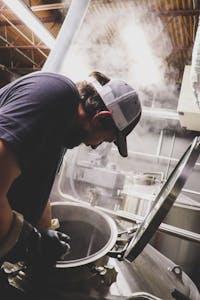
Sour Beer in Belgium
To say that brewing beer is an important part of Belgium culture would be an understatement. Brewing and beer culture is an integral part of Belgian traditions. Much work goes into maintaining this and educating people through classes by master brewers and even university courses.
In 2016, “Beer culture in Belgium” was actually added to the UNESCO Representative List of the Intangible Cultural Heritage of Humanity. This list aims to draw attention to the importance of safeguarding intangible heritage and to raise awareness about its importance.
This dedication to beer culture is reflected in the brewer’s approach to sour beer. Belgian brewers value traditional methods, and keeping sour beer to the correct standard is of paramount importance. To illustrate, many of the big brewers in Belgium are members of a committee known as HORAL – which stands for Hoge Raad Voor Ambachtelijke Lambikbieren (High Council for Traditional Lambic Beers). This committee’s sole purpose is to keep the standards of lambic beer legally in place. A lot of work has gone into protecting specific Belgium beer and brewing terms, and there is now a European Union Quality Standard – a TSG (Traditional Speciality Guaranteed) – in place for Gueuze, Lambic, Kriek, and Faro terms, meaning that legally a beer has to meet certain criteria regarding the production method, for it to be called a “Lambic beer” or a “Gueuze.” The quality standard specifies that the beer is made using spontaneous fermentation and specifies the type of bacteria within, the pH, and the bitterness. Before passing this standard, an official inspection of the beer is made, including laboratory testing.
It may be surprising to learn of the huge efforts made simply to protect some beer-related words, but it truly demonstrates the values of these Belgian brewers – they want to ensure that when you purchase one of these beers, you are getting the authentic product made the traditional way.
Sour Beer in America
The modern history of sour beers in America really only started in the 1970s-80s, when Belgian imported sours became available, such as those from the famous Brussels brewery, Cantillon.
Around this time, many American brewers started to research the traditional methods of brewing sours, and many traveled to Belgium to learn the process so they could create their own. Thus, a new generation of sour enthusiasts was born!
It was the breweries in Belgium that inspired us at Casey Brewing to start blending and brewing sour beers. Our owner, head brewer, and blender, Troy Casey says: “Emily and I first visited Belgium in 2012. We were inspired by the family-owned and operated lambic breweries like Cantillon, Drie Fonteinen, and Boon. They take so much pride in their business, and it really shows in their lambic beer”.
How are American Sour Beers Different from Belgium Sours?
In contrast to Belgian brewing, there are no set parameters for brewing American sour beers. They may be created by either spontaneous fermentation or mixed fermentation. While being inspired by Belgian methods, American brewers use these more as a starting point but continue to experiment with the variables to discover new possibilities and new ways of creating exciting flavor profiles.
Here at Casey Brewing, we express our creative flair through this experimentation. Blending batches, using spirit or wine barrels, adding new types of fruit we’ve not used before – all such experiments are performed without knowing whether or not they will be successful. This willingness to explore all possibilities is a defining feature of American sour beers.
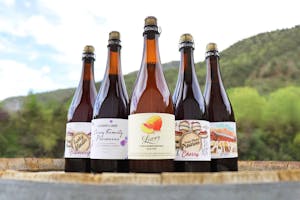
Take, for example, “Funky Blender – D’anjou Pear” a brand new fruited sour that is part of the collection of beers released to our Casey Brewing Extended Family members in April 2022. The idea for this beer was born when one of our growers from Paonia, Colorado, reached out to us to ask if we would like some pears. This was the first time we had worked with pears, and we love the result.
We put a lot of time and thought into blending batches together, in fact, when we first opened back in 2013, our focus was primarily on blending, and we found even when using the same beers, the results can be so different. For example, in 2017, Troy and Emily Casey, owners of Casey Brewing, did their first “blend off” where they each created a blend of Funky Blender from the same available barrel stock. Interestingly enough, the blends didn’t have any overlapping barrels, so both were totally different. After the beer was conditioned for months in the bottle, both blends were blindly served at a party in Denver, and the guests got to vote on which one they liked the most. Troy says: “Emily and I thought each other’s blend was the best! I ended up winning by one vote, so it was very close! We recently did this again and expect to hold many sessions later this year!”
At Casey Brewing, we live and breathe this creative space in brewing. We take it seriously and never blend or experiment as a gimmick or chase the newest trends. If one of our barrels doesn’t meet the cut, we pour it out and start again.
What Food Pairs Well with Sour Beers?
Sour beers can pair well with many foods. Some may shy away from serving sour beer alongside food but provided you choose foods with a robust individual flavor, sour beer can be a refreshing accompaniment. Foods that pair exceptionally well include:
Cheese: Strong cheeses like Goat, Blue, and a sharp cheddar pair with fruited sour beers, such as our newly released Funky Blender – D’Anjou Pear. We love pairing this with soft cheeses like goat cheese or triple cream brie.
Spicy food: Tacos, Fajitas, Chilli – just as you serve these with slices of lime – all pair well with a sour beer to offset the spice with a tart, lively taste profile.
Seafood: Shellfish such as Mussels, Oysters, and Clams served with lemon and butter.
Meats: Cured and salty meats such as pork and sausage are complimented well by a sour beer to refresh the palate, as are ribeye steaks or duck dishes.
Fattier food: The acidity of a sour beer cuts through the richness of these foods, which makes it a good pairing for anything rich. Try one of our base sours with a nice grilled steak. Again, the acidity from the beer cuts right through and makes for an excellent and easy pairing.
Desserts: Fruited sour beers pair nicely with cheesecake, fruit salad, or even ice cream. A fruited sour we would recommend as a dessert beer is Funky Blender Preserves – Balaton Cherry. This beer is rich in cherry pie and cinnamon notes. Its flavors are perfect for pairing with vanilla ice cream! If you are feeling brave, scoop some ice cream and pour some of the beer over the top for a cherry vanilla ice cream float!
What is a Normal ABV for Sour Beers?
The ABV for our sour ale ranges from around 4.5%- 7%.
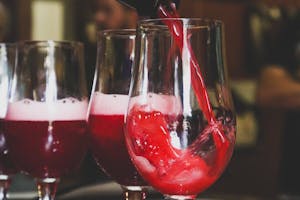
Casey Brewing OG Beers:
Here’s a run-through of some of our OG beers:
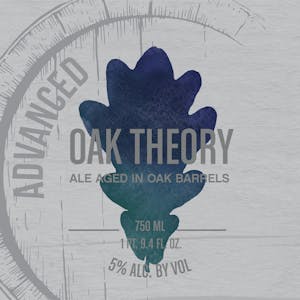
Advanced Oak Theory
Oak Theory is fermented and aged in specialty oak barrels, where the oak barrel provides a noticeable flavor. We have used barrels from local whiskey distillers such as Stranahan’s and Woody Creek. ABV – 5%
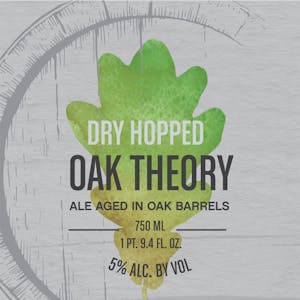
Dry-Hopped Oak Theory
We took unique barrels of Oak Theory and added massive amounts of dry hops just before bottling to add citrus and juicy notes to the rustic funk of Oak Theory. We have used different combinations of hops such as Simcoe and Galaxy, Citra and Mosaic, Nelson and Motueka – no two batches are the same. ABV – 5%

Funky Blender
A special brew. We added additional yeast cultures to our house culture and barrel fermented a unique Saison recipe. Each batch is an example of our purest form of blending. ABV – 7%
How to Serve Sour Beers
The recommended way to serve a sour beer is in a tulip glass. This keeps the head of the beer and retains the aromas within the glass, adding more to the taste experience. Pour slowly into a tilted glass, as you would with any beer, straightening the glass as it fills up.

How to Store Sour Beer
There are many ideas and theories about the best way to store your sour beer, but the truth is there are no particular rules you need to follow. Simply store the beer however you can. You do not need to store the bottles on their sides or in a temperature-controlled environment. Will doing these things hurt your beer? Not at all, but in our experience, it is just not required to make the beer taste better or last longer. The beer will still taste great sitting upright in your drinks cabinet for a few months.
Why We Cork Our Sour Beers
At Casey, we use our corking machine to cork our bottles. Using a cork is not just aesthetically pleasing, it is also necessary to allow pressure variations from any gas produced by refermentation in the bottle and provides a better seal than a cap, allowing less air to get into the beer, which means our bottles age slower.
Tasting Your First Sour Beer
You cannot prepare yourself for the first time you try a sour beer. Reading the definition of it and understanding its process is one thing but drinking one is a personal experience. Ask any beer drinker you know if they remember their first sour beer and you will get a grin and a nod, it’s not something you forget. The first sip stuns the system; it isn’t surprising for the first reaction to be that of concern, wondering if there is something wrong with the beer itself. Pause for a moment, then go in for the second sip. With the shock gone, you start to taste the beer, the complexity of it, and (if applicable) the notes created by the fruit. Pause one last time, and go in for the third sip. It is on the third sip or, just maybe, the fourth sip, the experience comes full circle, and for most of us, we are hooked.

Getting Started with Sour Beers
You’re in for a treat if you’ve never tried a sour beer before! We recommend starting with one of our lightly fruited farmhouse ales. The fruit flavors will presumably be familiar to you and help balance the potential shock of acidity that comes with the territory. Our farmhouse beers are almost always on the medium to lower side of acid, so after a couple of sips, your pallet should quickly adjust to the tartness. We hope you’ll then enjoy the complexity of the base beer as well as the juicy whole fruit notes!
Sour Beer Price Points
Given the time, expense, and attention required to brew a sour beer, pricing is more comparable to wine than your average IPA or Lager.
Just as you would expect any artisan, hand-crafted product to cost more, with sour beers you are paying for the process and its skillful craft. The carefully sourced products and equipment, and thoughtfully researched methods in themselves take time to decide upon, and that’s before the years of fermentation and aging, which requires time, patience, and more equipment and space. At Casey, we source 99% of our ingredients locally and take time to source and build relationships with our growers, regularly visiting to check on crops. We even hand-pick some fruits ourselves, ensuring only the best-tasting fruit is used in our sours. We then hand-process thousands of pounds of fruit after it is delivered to us. We can truthfully say that a batch of our sour beer is the result of thousands of hours of work and loving care.
Of course, this is reflected in the quality of our end product. From a barrel-aged sour, you can enjoy a complex taste with carefully balanced flavors, not to mention the knowledge that what you are drinking is one of a kind, enjoyed by only you and the few others enjoying this batch.
At Casey, the way we ferment and blend our beers means that no two batches are the same. So while each month we have new brews ready for drinking, we only ever have limited quantities. For this reason, we offer our Extended Family Membership, a way for our fans to get regular guaranteed access to our limited-run beers.
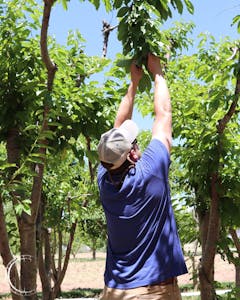
We offer first access for some blends, and often small-batch blends are offered exclusively to our Extended Family Members. Some of the exciting one-off sour blends available in 2022 include Red Currants, Marionberry, Elderberry, Peach, Cinnamon + Vanilla, Laroda Plums, and many more! If you would like to learn more about our Extended Family program – CIick Here
Applications for the 2023 membership will open in October 2022.
If you’re passing through the Roaring Fork Valley, come visit our Taproom in downtown Glenwood Springs to enjoy a sample of our unique sour beers.
